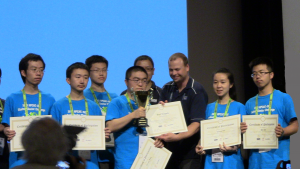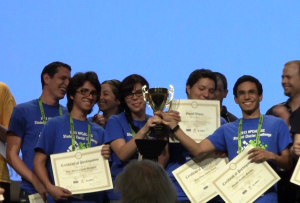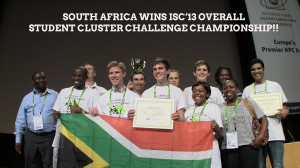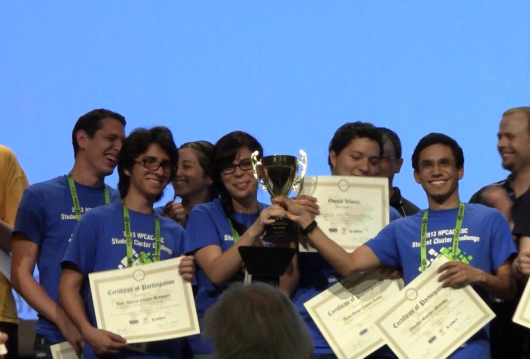Last week saw another exciting Student Cluster Competition move from the Leipzig ISC’13 exhibit hall battlefield into the annals of history. The official results are as follows:
Highest LINPACK
| University | LINPACK Score (TFlop/s) |
| Huazhong University of Science & Technology |
8.455 |
| EPCC (Edinburgh University) |
8.321 |
| Tsinghua University |
8.132 |
All three of these scores are new student cluster world records and are significantly higher than the previous world record results achieved in April at the Asia Student Supercomputer Challenge.
 It’s surprising to see how quickly the students have advanced the LINPACK frontier in just the past year.
It’s surprising to see how quickly the students have advanced the LINPACK frontier in just the past year.
At the 2012 ISC competition, the top LINPACK came in at 2.561 TFlop/s. The new high-water mark, set at ISC’13 last week, is a little over 3x higher.
Looking at the chart above, we see that LINPACK scores are a full 8x higher now vs. 2010, when SCC teams first breached the TFlop/s barrier.
If scores were simply tracking up at a Moore’s Law-like rate, we’d be seeing a max LINPACK somewhere in the 4TFlop/s neighborhood.
The top three finishers in LINPACK had a significant lead over the rest of the field. The fourth highest LINPACK score of 6.371 was turned in by Team South Africa, who won the coveted Overall Championship award.
Fan Favorite Award
 Competition for the Fan Favorite award wasn’t nearly as tight as the races for LINPACK or Overall Champion. The Costa Rica Rainforest Eagles (2.0) had more than 75% of the thousands of votes received, taking the Fan Favorite crown in a walk. The voting this year was primarily online, with safeguards in place to prevent ballot stuffing or automated scripts.
Competition for the Fan Favorite award wasn’t nearly as tight as the races for LINPACK or Overall Champion. The Costa Rica Rainforest Eagles (2.0) had more than 75% of the thousands of votes received, taking the Fan Favorite crown in a walk. The voting this year was primarily online, with safeguards in place to prevent ballot stuffing or automated scripts.
Overall Championship Play by Play
The contest for the overall championship was very tight this year. Only three of the eight teams managed to turn in a result for each of the three disclosed scientific apps (WRF, GROMACS, and MILC) and the two surprise apps (AMG and CP2K).
As those of you who avidly follow the world of student clustering know, Leipzig witnessed the biggest upset in Student Cluster Competition history when an unheralded South African CHPC team came out of nowhere to take the overall award.
The heavily favored Team Tsinghua landed in second place, finishing a single percentage point behind South Africa. On the application and interview categories, CHPC and Tsinghua traded the lead, with Tsinghua posting top scores on HPCC and AMG while splitting WRF, GROMACS, and CP2K with CHPC.
The other teams were not shut out. Huazhong won one MILC dataset outright and finished in second or third on a number of others. Team Edinburgh topped the field on another MILC data set and finished second on the other. Team Chemnitz, with their “Coffee Table of Doom,” grabbed third place on HPCC, GROMACS, and one of the WRF datasets.
One of the surprise apps, CP2K, was a backbreaker for most of the field. Only Huazhong, South Africa, and Tsinghua were able to complete both of the CP2K datasets.
South Africa Triumphs Against All Odds
 No one (including me) gave the South African team much of a chance to win at ISC’13. The odds were stacked against them in a number of ways. First, they were one of the youngest and least experienced teams ever to participate in a competition – all undergrad students, and young undergrads at that.
No one (including me) gave the South African team much of a chance to win at ISC’13. The odds were stacked against them in a number of ways. First, they were one of the youngest and least experienced teams ever to participate in a competition – all undergrad students, and young undergrads at that.
They also didn’t have access to the actual equipment they were going to use at the competition during their training period. Teams typically get a chance to play around with their configured cluster well before the beginning of the contest, but South Africa didn’t have this luxury.
In fact, their equipment was a day late arriving in Leipzig, meaning the team lost vital preparation and test time. Fortunately, the system that was delivered was in tip-top shape, with no hardware or software problems.
It was not lost on the team that they were considered an underdog. One CHPC team member humorously assailed me after the awards ceremony, saying, “No one thought we could win, no one gave us a chance, even the media was against us…” By “media,” he meant me, and these blogs – which is kind of cool. I’ve never been considered “the media” before.
I think the reason CHPC won is because they outworked the rest of the field. They were the first team to arrive at the hall in the morning and last team to leave at the end of the day. Every team member was busy in the booth whenever I glanced over at them.
And after the exhibit hall security guards kicked them out at night, they said, they headed to their hotel and worked on upcoming applications well into the early hours of the morning. All of this effort paid off in a big win at Leipzig.
So South Africa has established itself as a player in the international Student Cluster community. While we won’t see a South African team at the upcoming SC competition in November (that field is already set), we might see them compete in the Asia Student Supercomputer Challenge next spring or at ISC’14.
Posted In: Latest News, ISC 2013 Leipzig
Tagged: supercomputing, HPC, LINPACK, Tsinghua University, ISC 2013, SC 2013, Huazhong University of Science & Technology, Student Cluster Challenge, Chemnitz University of Technology, The University of Edinburgh, Centre for High Performance Computing, Costa Rica Institute of Technology, Results


Pingback: Student Cluster Competition
Pingback: Student Cluster Teams Defy Moore’s Law at ISC’13 | insideHPC.com